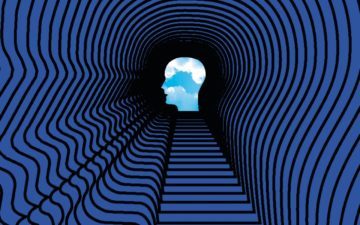Steve Paulson in Nautilus:
When he was a boy, Mark Solms obsessed over big existential questions. What happens when I die? What makes me who I am? He went on to study neuroscience but soon discovered that neuropsychology had no patience for such open-ended questions about the psyche. So Solms did something unheard of for a budding scientist. He reclaimed Freud as a founding father of neuroscience and launched a new field, neuropsychoanalysis. I reached Solms in Cape Town, South Africa, where he’s stayed during the COVID-19 lockdown. We talked about the brain-mind problem, the biases of neuropsychology and how a family trauma shaped the course of his life.
There are huge debates about the science of consciousness. Explaining the causal connection between brain and mind is one of the most difficult problems in all of science. On the one hand, there are the neurons and synaptic connections in the brain. And then there’s the immaterial world of thinking and feeling. It seems like they exist in two entirely separate domains. How do you approach this problem?
Subjective experience—consciousness—surely is part of nature because we are embodied creatures and we are experiencing subjects. So there are two ways in which you can look on the great problem you’ve just mentioned. You can either say it’s impossibly difficult to imagine how the physical organ becomes the experiencing subject, so they must belong to two different universes and therefore, the subjective experience is incomprehensible and outside of science. But it’s very hard for me to accept a view like that. The alternative is that it must somehow be possible to bridge that divide.
The major point of contention is whether consciousness can be reduced to the laws of physics or biology. The philosopher David Chalmers has speculated that consciousness is a fundamental property of nature that’s not reducible to any laws of nature.
I accept that, except for the word “fundamental.” I argue that consciousness is a property of nature, but it’s not a fundamental property. It’s quite easy to argue that there was a big bang very long ago and long after that, there was an emergence of life. If Chalmers’ view is that consciousness is a fundamental property of the universe, it must have preceded even the emergence of life. I know there are people who believe that. But as a scientist, when you look at the weight of the evidence, it’s just so much less plausible that there was already some sort of elementary form of consciousness even at the moment of the Big Bang. That’s basically the same as the idea of God. It’s not really grappling with the problem.
More here.
 In the study, investigators reported the extensive presence of mouse viruses in patient-derived xenografts (PDX). PDX models are developed by implanting human tumor tissues in immune-deficient mice, and are commonly used to help test and develop cancer drugs.
In the study, investigators reported the extensive presence of mouse viruses in patient-derived xenografts (PDX). PDX models are developed by implanting human tumor tissues in immune-deficient mice, and are commonly used to help test and develop cancer drugs.
 According to the late Christopher Lasch, the advent of mass production and the new relations of authority it introduced in every sphere of social life wrought a fateful change in the prevailing American character. Psychological maturation—as Lasch, relying on Freud, explicated it—depended crucially on face-to-face relations, on a rhythm and a scale that industrialism disrupted. The result was a weakened, malleable self, more easily regimented than its pre-industrial forebear, less able to withstand conformist pressures and bureaucratic manipulation—the antithesis of the rugged individualism that had undergirded the republican virtues.
According to the late Christopher Lasch, the advent of mass production and the new relations of authority it introduced in every sphere of social life wrought a fateful change in the prevailing American character. Psychological maturation—as Lasch, relying on Freud, explicated it—depended crucially on face-to-face relations, on a rhythm and a scale that industrialism disrupted. The result was a weakened, malleable self, more easily regimented than its pre-industrial forebear, less able to withstand conformist pressures and bureaucratic manipulation—the antithesis of the rugged individualism that had undergirded the republican virtues. The first note known to have sounded on earth was an E natural. It was produced some 165 million years ago by a katydid (a kind of cricket) rubbing its wings together, a fact deduced by scientists from the remains of one of these insects, preserved in amber. Consider, too, the love life of the mosquito. When a male mosquito wishes to attract a mate, his wings buzz at a frequency of 600Hz, which is the equivalent of D natural. The normal pitch of the female’s wings is 400Hz, or G natural. Just prior to sex, however, male and female harmonise at 1200Hz, which is, as Michael Spitzer notes in his extraordinary new book, The Musical Human, ‘an ecstatic octave above the male’s D’. ‘Everything we sing’, Spitzer adds, ‘is just a footnote to that.’
The first note known to have sounded on earth was an E natural. It was produced some 165 million years ago by a katydid (a kind of cricket) rubbing its wings together, a fact deduced by scientists from the remains of one of these insects, preserved in amber. Consider, too, the love life of the mosquito. When a male mosquito wishes to attract a mate, his wings buzz at a frequency of 600Hz, which is the equivalent of D natural. The normal pitch of the female’s wings is 400Hz, or G natural. Just prior to sex, however, male and female harmonise at 1200Hz, which is, as Michael Spitzer notes in his extraordinary new book, The Musical Human, ‘an ecstatic octave above the male’s D’. ‘Everything we sing’, Spitzer adds, ‘is just a footnote to that.’ We tested 100 participants twice on a range of tests: some took them first in summer and then winter, and some in the opposite order. Among the tasks, there was a test of pure speed (‘press this button as quickly as possible as soon as you see a circle in the middle of the screen’); a test of immediate memory for digits; a test of memory for words presented
We tested 100 participants twice on a range of tests: some took them first in summer and then winter, and some in the opposite order. Among the tasks, there was a test of pure speed (‘press this button as quickly as possible as soon as you see a circle in the middle of the screen’); a test of immediate memory for digits; a test of memory for words presented  Take a look at the numbers 294,001, 505,447 and 584,141. Notice anything special about them? You may recognize that they’re all prime — evenly divisible only by themselves and 1 — but these particular primes are even more unusual.
Take a look at the numbers 294,001, 505,447 and 584,141. Notice anything special about them? You may recognize that they’re all prime — evenly divisible only by themselves and 1 — but these particular primes are even more unusual. For several decades, child advocates have tried to bring more public indignation to the scandal of extreme child poverty, and have pushed for the expansion of the Child Tax Credit. In recent years, some progressives have called for something that seemed even more utopian, a universal basic income.
For several decades, child advocates have tried to bring more public indignation to the scandal of extreme child poverty, and have pushed for the expansion of the Child Tax Credit. In recent years, some progressives have called for something that seemed even more utopian, a universal basic income. What is the matrix? Without resorting to pharmaceuticals in various chromatic registers—red, blue—and the versions of paranoid reality such pills might produce, it feels right to recall the ways this concept has been deployed in mediums neither cinematic nor far-right political. In the early 1990s,
What is the matrix? Without resorting to pharmaceuticals in various chromatic registers—red, blue—and the versions of paranoid reality such pills might produce, it feels right to recall the ways this concept has been deployed in mediums neither cinematic nor far-right political. In the early 1990s,  What’s so fantastic about seeing these paintings at the Frick Breuer is not only how close you can get to the work, now that it’s not surrounded with furniture and bric-a-brac. In the mansion, the Fragonards are installed — even swaddled and segregated — in a wonderful Rococo drawing room, with attendant panels over doors and next to windows. Here, the work is given pride of place on the fourth floor next to the gigantic trapezoidal window looking out over Madison Avenue. Up close and at eye level, the work is reborn as these huge heraldic thunderous paintings, visually vehement and emotionally commanding. I love them more than I ever have.
What’s so fantastic about seeing these paintings at the Frick Breuer is not only how close you can get to the work, now that it’s not surrounded with furniture and bric-a-brac. In the mansion, the Fragonards are installed — even swaddled and segregated — in a wonderful Rococo drawing room, with attendant panels over doors and next to windows. Here, the work is given pride of place on the fourth floor next to the gigantic trapezoidal window looking out over Madison Avenue. Up close and at eye level, the work is reborn as these huge heraldic thunderous paintings, visually vehement and emotionally commanding. I love them more than I ever have. When the London-based neurologist Suzanne O’Sullivan flew to Sweden to visit a sick girl in a small town north-west of Stockholm, the child did not acknowledge her. Not when O’Sullivan entered her bedroom, or when she knelt down to introduce herself, or even when she examined her. Nola (not her real name) wasn’t trying to be rude. It had been more than a year since she had got out of bed, opened her eyes or moved at all. A feeding tube, taped to her cheek, kept her alive.
When the London-based neurologist Suzanne O’Sullivan flew to Sweden to visit a sick girl in a small town north-west of Stockholm, the child did not acknowledge her. Not when O’Sullivan entered her bedroom, or when she knelt down to introduce herself, or even when she examined her. Nola (not her real name) wasn’t trying to be rude. It had been more than a year since she had got out of bed, opened her eyes or moved at all. A feeding tube, taped to her cheek, kept her alive.